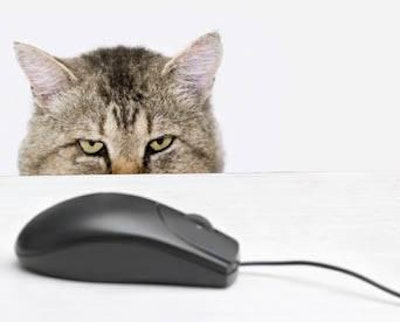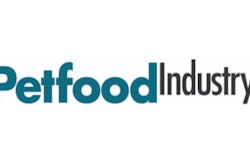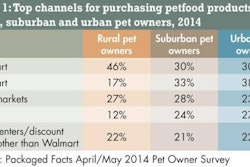
According to IBISWorld’s Online Pet Food & Pet Supply Sales market research report, the online market size for petfood, treats and supplies sold on the Internet will reach US$3.2 billion in 2014. That's an annual growth rate of 7.8% (from 2009–2014, projected). Online petfood sales totaled US$666 million in 2011, according IBISWorld. The food and treat category comprised roughly 33% of the US$2 billion online pet-related sales in 2011.
"With rising pet ownership among US households and more owners humanizing their pets, online petfood and supply stores have fared well over the five years to 2014," says IBISWorld. "Increasing popularity of premium petfood supplies has also fueled industry growth over the period; since premium goods are typically priced higher, they provide a good source of revenue for players. Nevertheless, increasing competition will likely constrain profit margins." Rising pet ownership in the US and growth across the e-commerce sector have caused the industry to experience overall growth, despite the recession.
Currently, the online petfood and treats industry exhibits a low level of concentration. The top four companies in this industry comprise a combined share of about 16.8% of total revenue from all online sales of pet supplies in 2014. Meanwhile, the majority of revenue is distributed among several other operations. "Some competitors, like Walmart, are large retailers that earn substantial overall revenue, but only a marginal share is relevant to the pet industry," explains the market report. "Other companies, like PetSmart, are wholly pet-related, but they earn only a marginal share of their revenue from online sales." Market share concentration has remained relatively stable during the past five years.
While most pet owners indicated they reduced spending on pet supplies during the recession, according to a survey conducted by Pet Business, many consumers gravitated online to purchase more-affordable substitutes in lower quantities. Per capita disposable income, expected to increase 3.1% in 2014, is expected to cause revenue growth of 2.5% in 2014. With rising revenue, industry profit margins have increased over the five-year period. According to IBISWorld Industry Analyst Andy Brennan, “Industry profit has risen due to improvements in automation, which caused wages to decline as a proportion of revenue.” Furthermore, premium petfood and supplies have boosted profitability because they typically have higher markups.
Niche operators will likely continue entering the industry during the next five years, especially those that specialize in targeted markets, such as supplies for exotic animals or health-oriented products. IBISWorld forecasts that industry revenue will increase in the five years to 2019. However, online pet retailers will also experience increasing competition from brick-and-mortar stores that also sell petfood and supplies, including grocery stores. “This trend is largely due to the closing of a tax loophole that has allowed many Internet retailers to forgo charging sales tax,” says Brennan. This factor is expected to cause profit margins to decline, since firms will need to reduce prices to remain competitive.
Wal-Mart faces increased competition from online sites of virtual stores like PetFoodDirect, MrChewy and PetFlow. Specialty retailers such as Petco and PetSmart also run active online businesses. PetSmart recently revamped its website and offers over 8,000 products which are not found in its stores. IBISWorld estimates virtual retailers like PetMeds Express, the parent company of 1800PetMeds.com, garner the biggest online market share in the industry. PetMeds Express has about 8.3% of the total share. The specialty retailer offers about 1,200 products online and through direct mail—71% of its sales are derived via the Internet.
Pet owners who earn more than US$70,000 per year represent the largest market segment for online pet supply retailers, according to the report. In 2011, IBISWorld estimated that this income segment accounted for 53% of total industry revenue. According to the Bureau of Labor Statistics, on average, these consumers spend nearly $700 a year on pets and supplies.
One competitor nipping away at market share is New York-based PetFlow.com. The online company says it shipped more than US$2.5 million to online customers in July 2012 and posted annual sales of US$30 million that year alone. The young company attributes its success to a subscription business model that automatically delivers the petfood to a customer’s front door. “Since our inception, PetFlow.com has experienced extreme growth, but the statistic we’re most proud of is the very high return rate of our pet-owning customers,” said Alex Zhardanovsky, co-founder of PetFlow.com. “The company’s growth demonstrates that our customers see their pet as a true family member and they profoundly prefer PetFlow.com’s subscription approach to purchasing petfood and supplies when compared to the traditional, big box retailer approach to shopping.”
PetFlow.com says it stocks more than 100 premium brands, more than three times the amount of its traditional retail competitors. The company also actively uses social media channels to create an ongoing dialog with its customers, introduce new products and engage the pet parent demographic.
On the global scale, online sales of petfood are going up in Australia, with the Internet market in a growth phase, brought on by expansion of products and services, according to Euromonitor. Over the past five years, online sales of cat food and other pet products have doubled. And a trend that is true in all petfood-purchasing countries, according to Euromonitor: Pet parents are mostly buying their petfood at retail grocery chains, at pet superstores and on the Internet.















